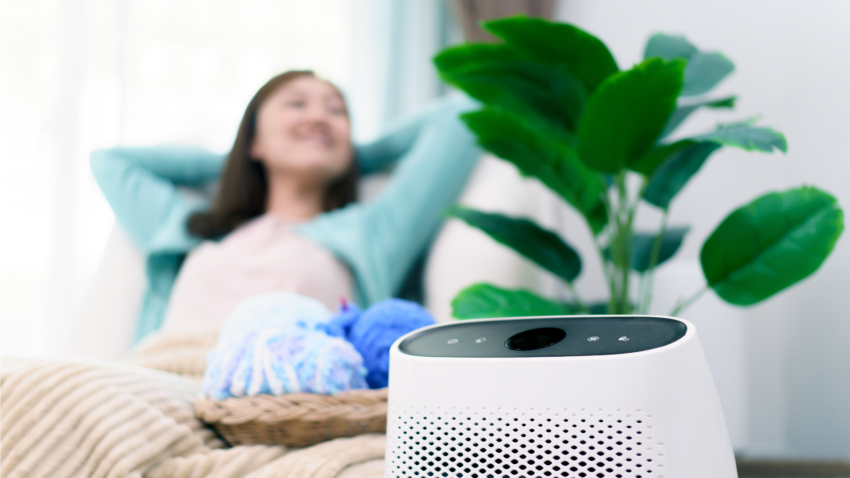If you’re looking to enhance your indoor air quality, adding houseplants to your indoor space is a great choice.
These natural air purifiers not only bring a touch of nature into your home or office building but also help combat indoor air pollution caused by volatile organic compounds (VOCs), carbon monoxide, and other airborne pollutants.
Many of these plants, including some highlighted in a famous NASA study, have been shown to improve air quality by filtering harmful toxins and producing clean air.
Here’s a list of the best air-purifying plants to brighten your living spaces and create a healthy environment, along with tips to keep them thriving.
1. Snake Plant (Sansevieria)
Why It’s Great: Known as mother-in-law’s tongue, the snake plant is one of the most effective at removing harmful chemicals like benzene, formaldehyde, and trichloroethylene. This hardy plant is also a great option for bedrooms as it absorbs carbon dioxide and releases oxygen even at night.
Care Tips:
- Thrives in low light to bright indirect light.
- Water sparingly; allow soil to dry out completely between waterings.
- A low-maintenance houseplant, perfect for beginners or those with a “black thumb.”
2. Peace Lily (Spathiphyllum)
Why It’s Great: The peace lily is not only a stunning plant with white flowers but also a natural air purifier, excelling at filtering indoor air pollutants like ammonia and VOCs.
Care Tips:
- Prefers low to moderate light conditions.
- Keep soil slightly moist and boost humidity by misting occasionally.
- Avoid overwatering to prevent root rot.
3. Spider Plant (Chlorophytum comosum)
Why It’s Great: The spider plant is a top performer for removing carbon monoxide, nitrogen oxides, and other airborne pollutants. This popular houseplant is incredibly easy to care for and safe for pets.
Care Tips:
- Thrives in indirect light but tolerates low light.
- Allow the soil to dry out between waterings.
- Ideal for both homes and office buildings.
4. Areca Palm (Dypsis lutescens)
Why It’s Great: The Areca palm, also known as the butterfly palm, is a perfect choice for improving indoor air quality while adding a tropical touch to your interior spaces. It doubles as a natural humidifier in dry climates.
Care Tips:
- Prefers bright indirect sunlight.
- Keep the soil moist but avoid overwatering.
- Suitable for living spaces with high humidity.
5. Boston Fern (Nephrolepis exaltata)
Why It’s Great: The Boston fern is not just a natural humidifier but also excellent at reducing indoor pollutants like formaldehyde and increasing humidity to combat respiratory problems.
Care Tips:
- Loves bright indirect light.
- Keep soil consistently moist.
- Regular misting ensures the plant thrives in high humidity.
6. Rubber Plant (Ficus elastica)
Why It’s Great: With its large, glossy leaves, the rubber plant removes toxins like formaldehyde, making it ideal for homes and offices.
Care Tips:
- Thrives in bright indirect light but tolerates low light.
- Water when the top inch of soil feels dry.
- Clean leaves to maintain their shine and health.
7. Bamboo Palm (Chamaedorea seifrizii)
Why It’s Great: This natural humidifier excels at filtering toxins while increasing moisture in the air. Its lush, graceful fronds make it a beautiful addition to any room.
Care Tips:
- Thrives in bright indirect sunlight but tolerates low light conditions.
- Keep soil lightly moist.
- Benefits from occasional misting.
8. Golden Pothos (Epipremnum aureum)
Why It’s Great: Also called Devil’s Ivy, this trailing plant is nearly indestructible and removes toxins like benzene and carbon monoxide.
Care Tips:
- Grows in low to bright indirect light.
- Water when the soil is dry.
- A low-maintenance plant, ideal for beginners.
9. ZZ Plant (Zamioculcas zamiifolia)
Why It’s Great: A striking plant with waxy, heart-shaped leaves, the ZZ plant is a low-maintenance champion for removing toxins like xylene and toluene.
Care Tips:
- Grows in low to bright sunlight conditions.
- Water sparingly, allowing soil to dry completely between waterings.
- A great option for forgetful plant parents.
10. Aloe Vera
Why It’s Great: In addition to its air-purifying properties, aloe vera offers health benefits like soothing burns. It’s excellent for filtering harmful toxins like formaldehyde.
Care Tips:
- Needs bright light or indirect sunlight.
- Let soil dry completely between waterings.
- Perfect for sunny indoor spaces.
11. Corn Plant (Dracaena fragrans)
The Corn Plant is a hardy and low-maintenance houseplant, known for its striking sword-like leaves with vibrant green and yellow stripes. It’s an excellent choice for improving indoor air quality.
Why It’s Great:
- Removes volatile organic compounds (VOCs) such as benzene and formaldehyde, contributing to cleaner, healthier indoor air.
- Adds a tropical vibe to your home with its bold, upright form.
Care Tips:
- Light Conditions: Tolerates low light but grows best in bright, indirect light. Avoid direct sunlight to prevent leaf scorching.
- Watering: Water when the top inch of soil feels dry. The root system is prone to rot if overwatered.
- Humidity: Prefers moderate to high humidity but adapts well to typical indoor environments.
- Placement: Ideal for bedrooms or offices due to its ability to tolerate low-maintenance care and conditions.
12. English Ivy (Hedera helix)
Why It’s Great: This perfect plant is highly effective at removing mold and allergens from the air, making it a great option for reducing health issues caused by indoor pollutants.
Care Tips:
- Prefers indirect sunlight.
- Allow the soil to dry out between waterings.
- Perfect for hanging baskets or climbing trellises.
13. Cast Iron Plant (Aspidistra elatior)
True to its name, the Cast Iron Plant is a robust and resilient option for those without a green thumb. Its dark, glossy leaves thrive in conditions where many other plants struggle.
Why It’s Great:
- Hardy enough to withstand environmental conditions like low light, irregular watering, and temperature fluctuations.
- Contributes to clean air by removing toxins like benzene and formaldehyde.
Care Tips:
- Light Conditions: Grows well in low to medium light. Avoid placing in direct sunlight, as it can scorch the leaves.
- Watering: Allow the top inch of soil to dry before watering. The plant is drought-tolerant but thrives with consistent care.
- Humidity: Adapts to a wide range of humidity levels.
- Placement: A great option for office buildings or indoor spaces with less natural light.
14. Fiddle-Leaf Fig (Ficus lyrata)
The Fiddle-Leaf Fig is a dramatic, elegant houseplant with large, violin-shaped leaves that bring a bold statement to interior spaces. While it requires more care than some other plants, its striking appearance makes it well worth the effort.
Why It’s Great:
- Improves indoor air quality by filtering out toxins.
- Makes a visual impact with its large leaves and upright growth habit.
Care Tips:
- Light Conditions: Requires bright, indirect sunlight. Rotate the plant occasionally to ensure even growth.
- Watering: Water when the topsoil is dry. Avoid overwatering, as it can lead to root rot.
- Humidity: Prefers high humidity. Use a humidifier or mist the leaves occasionally to mimic its native tropical environment.
- Placement: Ideal for living spaces or offices where it can receive ample light.
15. Weeping Fig (Ficus benjamina)
The Weeping Fig, also known as Ficus benjamina, is a popular houseplant prized for its graceful, arching branches and glossy, small leaves. Its ability to filter indoor air pollutants makes it a valuable addition to any space.
Why It’s Great:
- Effective at removing airborne toxins, including benzene, formaldehyde, and trichloroethylene.
- Aesthetic appeal with its lush, tree-like form, making it a perfect plant for corners or larger spaces.
Care Tips:
- Light Conditions: Requires bright, indirect sunlight. Rotate the plant occasionally to ensure even growth.
- Watering: Water when the topsoil is dry. Avoid overwatering, as it can lead to root rot.
- Humidity: Prefers high humidity. Use a humidifier or mist the leaves occasionally to mimic its native tropical environment.
- Placement: Ideal for living spaces or offices where it can receive ample light.
Maximizing Air Purification in Indoor Environments
- Place multiple plants in high-traffic areas to create an air-cleansing station.
- Combine plants like the peace lily, snake plant, and areca palm for the best results.
- Use a humidifier or mist plants like the Boston fern to replicate tropical environmental conditions.
- Regularly clean leaves to remove dust and maximize their air-purifying efficiency.
Is there Any Proof of All of This?
The famous NASA study on air purification conducted in sealed chambers demonstrated the effectiveness of plants like the spider plant, rubber tree, and weeping fig at removing toxic chemicals from the air.
While the study was originally conducted for space stations, the findings are applicable to interior spaces in your home or workplace.
Adding these best plants for air quality to your home is a natural way to reduce indoor air pollutants, combat sick building syndrome, and create a healthier environment.
Whether you’re looking for low-maintenance plants like the snake plant or statement pieces like the fiddle-leaf fig, there’s a perfect plant for every space and style.
Wolverton, B.C., Johnson, A., & Bounds, K. (1989). Interior Landscape Plants for Indoor Air Pollution Abatement. NASA, Stennis Space Center, Report Number: NASA-TM-101766.

